

Discovering Path MTU black holes in the Internet using RIPE Atlas Maikel de Boer Jeffrey Bosma 5 July 2012
Introduction • Black holes – “A sphere of influence into which or from which communication or similar activity is precluded.” ~ Wiktionary.org • In layman’s terms: what goes in is forever lost – The Internet is full of black holes • Many possible causes – E.g., misconfiguration, bugs in software, etc. • We focus on Path MTU black holes 2
Research questions Where on the Internet do Path MTU black holes occur? Do Path MTU black holes occur more often in the IPv6-Internet compared to IPv4? 3
Theory • The Internet: enormous collection of links • Maximum Transmission Unit (MTUs) on network interface – Limits the amount of data in packets • Two-way limit: sending and receiving • Path MTU (RFC1191) – Highest possible MTU for entire path • Determined by link with smallest MTU • Internet Path MTU is commonly 1500 bytes – Not always the case – Requires Path MTU detection mechanism 4
Theory Path MTU Discovery (PMTUD) 5
Theory Problem #1: ICMP PTB filtering 6
Theory Problem #2: fragment filtering 7
RIPE Atlas • Internet measurement system • Driven by probes – USB-powered embedded devices • Default measurement functionality: – ping – traceroute • Currently around 1700 probes up and running – Located primarily in the RIPE NCC service region • But also other regions around the globe 8
RIPE Atlas Worldwide network of probes 9
Research questions Where on the Internet do Path MTU black holes occur? Do Path MTU black holes occur more often in the IPv6-Internet compared to IPv4? 10
Experimental setup ICMP PTB filtering POST / HTTP/1.1 Host: httppost6.uranus.nlnetlabs.nl Connection: close MTU: 1500 User-Agent: httpget for Internet Chummi atlas.ripe.net Content-Type: application/x-www- MTU: 1280 form-urlencoded Content-Length: 65528 MTU: 1500 Belgrade Running: Apache 2.0 11
Experimental setup Fragment filtering version.bind. 60 CH TXT 1,002,003,004,005,006,007,008,00 9,010,011,012,013,014,015,016,01 7,018,019,020,021,022,023,024,02 5,026, MTU: 1500 Chummi 33,334,335,336,337,338,339,340,3 41,342,343,344,345,346 Internet 347,348,349,350,351,352,353,354, 355,356,357,358,359,360,361,362, Running: LDNS-TESTNS 363,364,365,366,367,368,369,370, 371,372,373,374,375,376,377,378, 379,380,381,382,383 MSG SIZE snd: 1590 12
Results ICMP PTB filtering IPv4 13
Results ICMP PTB filtering IPv6 14
Results 100 ICMP PTB filtering MTU 1280 0 15
Results 100 ICMP PTB filtering MTU 1500 0 16
Results Fragment filtering IPv4 17
Results Fragment filtering IPv6 18
Results Fragment filtering 100 0 19
Hop counting Belgrade 1 2/4 2 1/3 4 1/1 5 1/1 3 0/3 probe 6 1/1 probe probe probe probe probe 20
Results Where do IPv4 ICMP PTB messages get filtered? Bad Total Error percentage Ip 69 1126 6.1% 145.145.19.190 53 810 6.5% 145.145.80.65 16 311 5.1% 145.145.80.73 13 214 6.1% 77.67.72.109 7 199 3.5% 109.105.98.33 2 60 3.3% 62.40.124.157 ... 2 2 100.0% 203.50.6.78 2 2 100.0% 203.50.6.89 2 2 100.0% 61.10.0.118 2 2 100.0% 80.231.159.10 2 2 100.0% 84.116.238.49 21
Results Where do IPv6 ICMP PTB messages get filtered? Bad Total Error percentage Ip 3 391 0.8% 2001:610:158:1916:145:100:99:17 2 292 0.7% 2001:610:e08:64::65 2 131 1.5% 2001:7f8:1::a500:6939:1 1 9 11.1% 2001:470:0:217::2 1 6 16.7% 2001:470:0:67::2 1 46 2.2% 2001:470:0:3f::1 ... No routers with 100% failure rate 22
Results Where do IPv4 fragments get filtered? Bad Total Error percentage Ip 143 1203 11.9% 145.145.19.190 103 861 12.0% 145.145.80.65 40 337 11.9% 145.145.80.73 36 219 16.4% 77.67.72.109 23 226 10.2% 109.105.98.33 9 54 16.7% 62.40.124.157 ... 2 2 100.0% 212.188.29.138 2 2 100.0% 216.66.41.110 2 2 100.0% 46.19.96.235 2 2 100.0% 62.154.32.74 2 2 100.0% 80.241.177.86 23
Results Where do IPv6 fragments get filtered? Bad Total Error percentage Ip 181 435 41.6% 2001:610:158:1916:145:100:99:17 138 322 42.9% 2001:610:e08:64::65 74 146 50.7% 2001:7f8:1::a500:6939:1 28 53 52.8% 2001:470:0:3f::1 27 91 29.7% 2001:610:e08:72::73 21 53 39.6% 2001:948:2:6::1 ... 6 6 100.0% 2001:610:f01:9012::14 4 4 100.0% 2001:16d8:aaaa:5::2 4 4 100.0% 2001:7f8:1::a503:9326:1 4 4 100.0% 2a01:348::10:0:1 4 4 100.0% 2a01:348::27:0:1 24
Conclusion • ICMP PTB messages get dropped – More for IPv4 but nobody notices – But not that often (anymore) • Fragments get dropped – More in IPv6 • Path MTU black holes – Occur on the edges of the Internet, not in the core 25
Recommendations • Recommendations for Filtering ICMPv6 Messages in Firewalls – RFC4890 • Don’t filter IPv4 ICMP type 3 code 4 • Packetization Layer Path MTU Discovery – RFC4821 • Don ’ t filter fragments (problems for DNSSEC) • Don’t reduce MTU on interface • No MSS clamping 26
Acknowledgements • NLnet Labs – Benno Overeinder – Willem Toorop • RIPE NCC – Philip Homburg – Andreas Strikos – Vesna Manojlovic – Emile Aben 27
Questions? Maikel de Boer – maikel.deboer@os3.nl Jeffrey Bosma – jeffrey.bosma@os3.nl 28
29
Results Path MTU determination IPv4 30
Results Path MTU determination IPv6 31
Recommend
More recommend